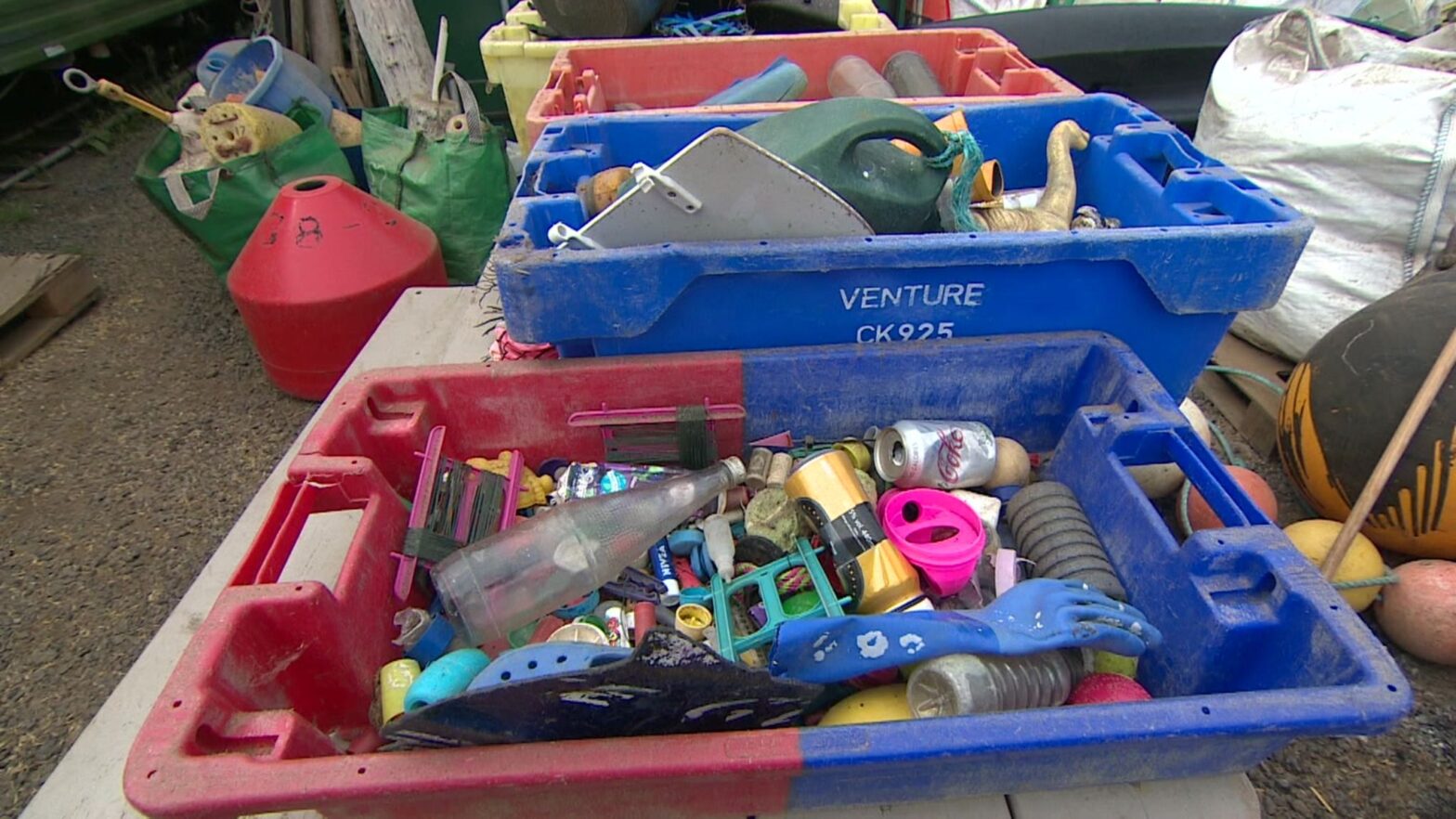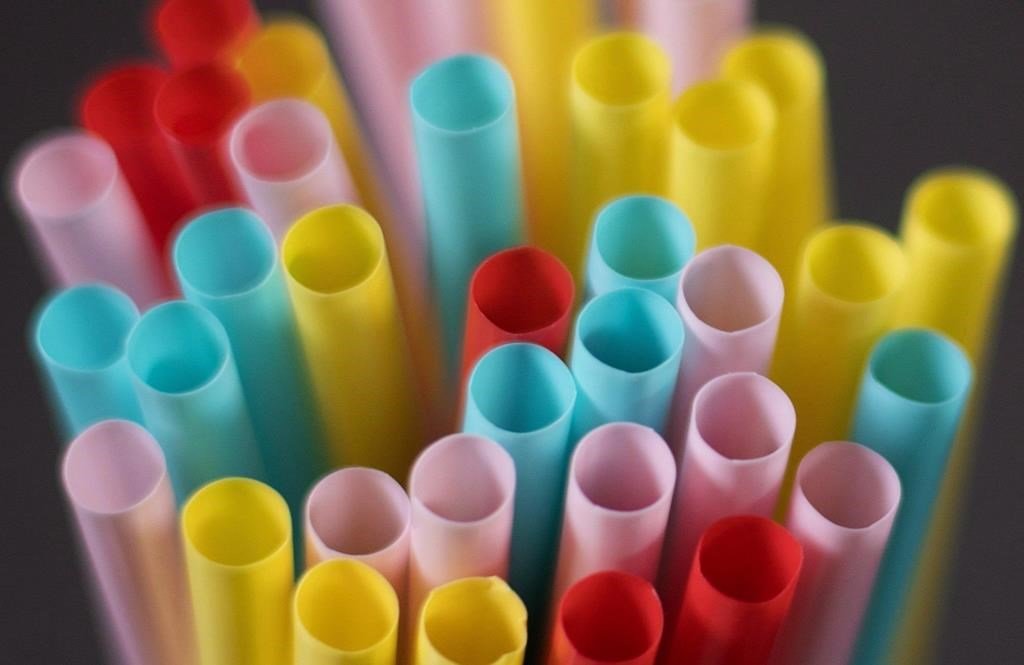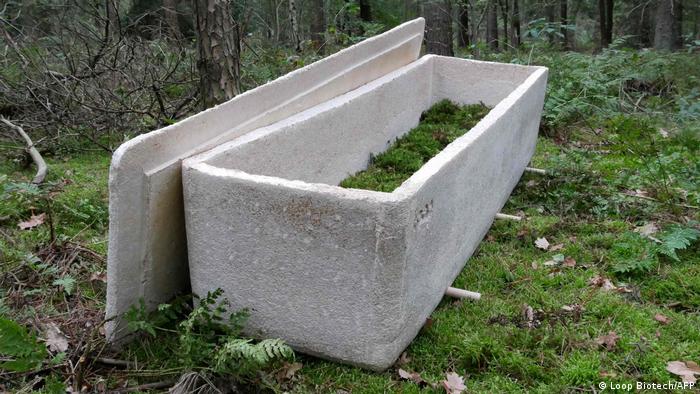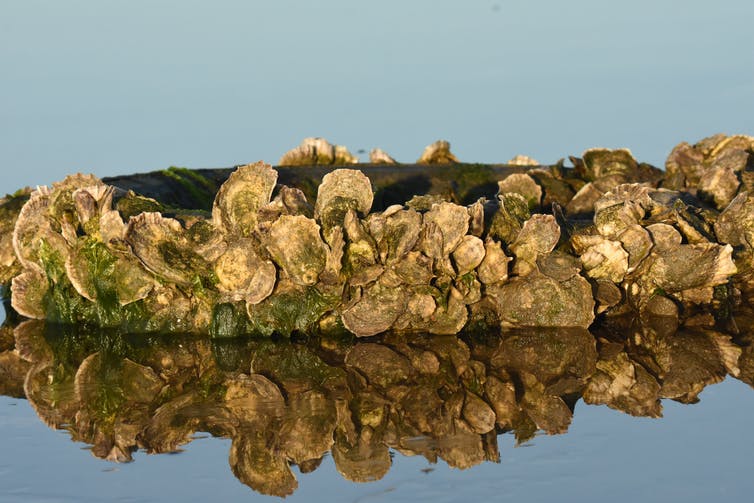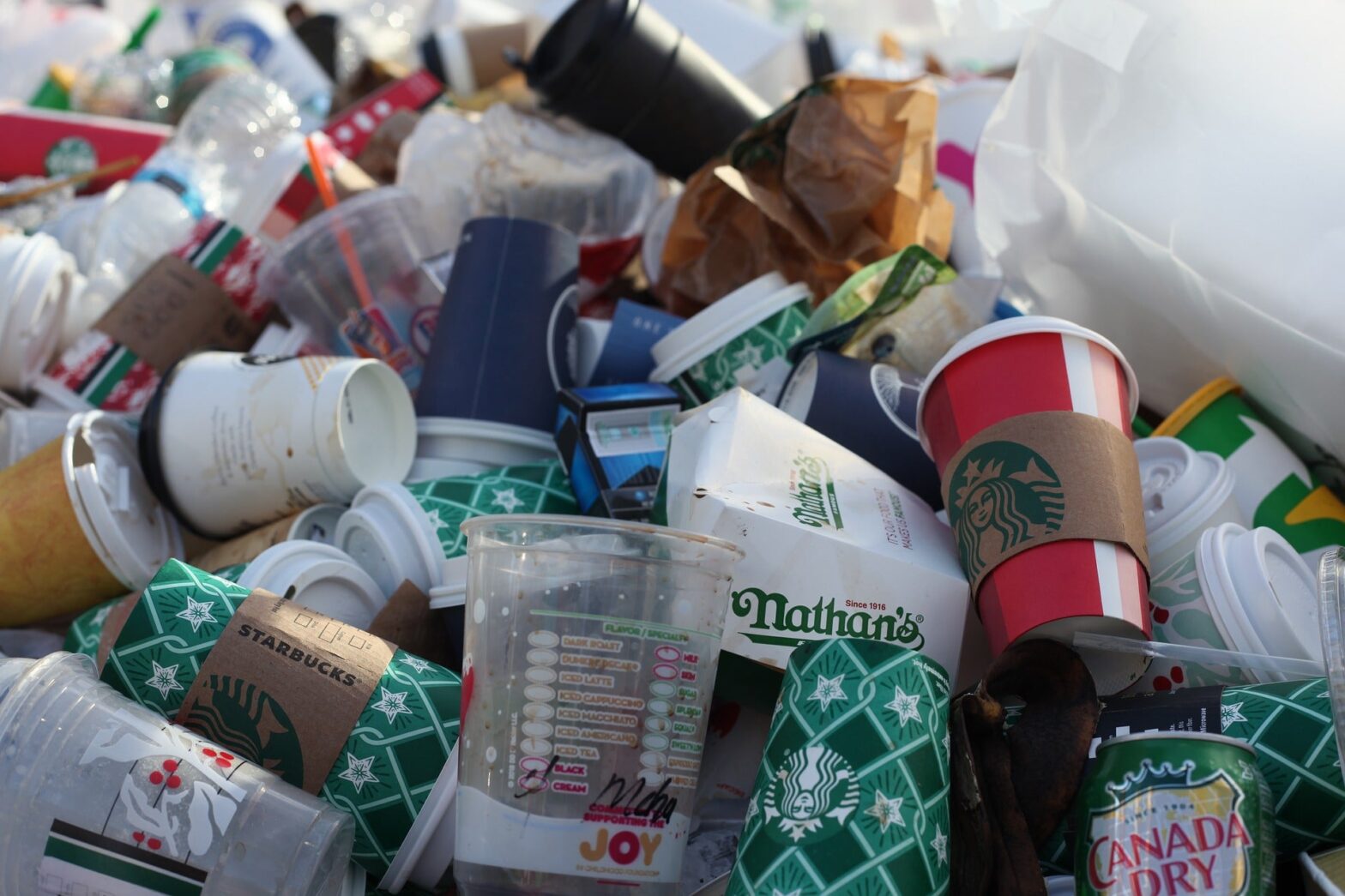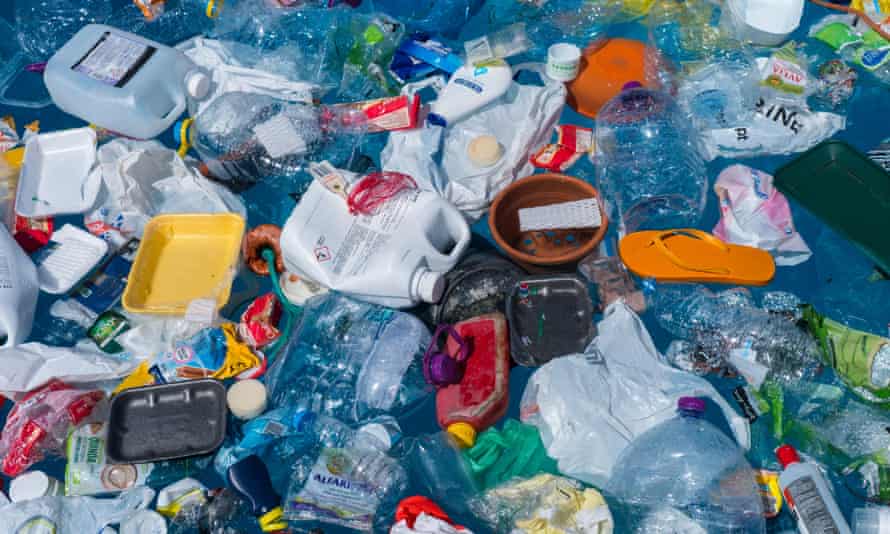6 hours agoA group which is installing a boom made of marine litter at a harbour in Devon hopes the structure will make people more aware of the impact they are having on the environment.It is hoped the boom in Brixham Harbour will stop floating plastic from reaching the inner seawall and getting trapped in the rocks.It will be made out of previously recovered waste such as buoys and containers and will be anchored by specially made reef cubes, which will provide a new habitat for marine creatures.Gary Joliffe, the director of Till the Coast is Clear, which is leading on the project, said: “It’s about working with the community and … getting everyone to work together to get to a point where litter is a rarity in the oceans, the seas and in our harbours, which we are a long way from at the moment.”The project will also involve a whale sculpture being installed on a pontoon in the harbour, which will double as a receptacle for the rubbish collected from the litter boom, to illustrate the scale of the problem and also the origin of some of the items.”We are hoping people will say ‘we need to tidy up our act’,” said Mr Joliffe.The project is funded by restaurant chain Rockfish.Till the Coast is Clear is a community interest company which launched in 2017. Since then, it has removed more than 12 tons of plastic and other waste from the South Devon coast using a recyclable boat and fleet of kayaks made from fishing nets.Mr Joliffe said: “We specialise in getting to areas that are pretty hard to reach, so coves, underlying cliffs and that sort of area.”Volunteer Rob Harris said: There is quite a lot [of litter] and my kids swim in the sea, they play on the beaches and if you think they are swimming around with all that in the sea … it’s quite depressing really.”The whale and litter boom are expected to be installed in September.
Author Archives: David Evans
Trees should be planted without plastic guards, says UK study
The age of extinctionEnvironment Trees should be planted without plastic guards, says UK study Woodland Trust and National Trust trial sustainable alternatives to plastic protection for millions of saplings The age of extinction is supported by About this content Phoebe Weston @phoeb0 Tue 24 Aug 2021 02.01 EDT Last modified on Tue 24 Aug 2021 …
Continue reading “Trees should be planted without plastic guards, says UK study”
Experts laud Montreal's plan to cut back on single-use plastics but say Canada has far to go
MONTREAL — Environmental experts are praising Montreal’s decision to ban some kinds of single-use plastics, but they say Canada is still a long way from being plastic-free despite government promises. Montreal Mayor Valérie Plante announced on Wednesday that the city would ban retailers and restaurants from distributing plastic bags in the city by end of August 2022. Six months later, a number of other single-use items will be banned, she said, including takeout food containers, cups, lids, utensils and stir sticks made from unrecyclable or hard-to-recycle plastics.Plante described her city’s plan as the most ambitious in North America, and she said what sets it apart is the focus on reducing plastic at the source. Get top stories in your inbox.Our award-winning journalists bring you the news that impacts you, Canada, and the world. Don’t miss out.”For some cities, recycling is priority No. 1,” she said. “For us, it’s reducing, reducing, reducing.” The mayor added that the urgency was heightened by the fact the city’s only landfill is expected to be full by 2029.Ashley Wallis, a plastics pollution expert with environmental charity Oceana Canada, described Montreal’s initiative as a “great step,” and she had particular praise for the decision to include drink cups on the list of banned items — something other governments, including Ottawa, have stopped short of doing.”We do know that 47 per cent of Canada’s plastic waste is from single-use plastics and plastics packaging, so I think there is a huge opportunity by focusing on things like these single-use takeaway items,” she said in a phone interview Wednesday. What people are reading However, Wallis said that despite cities’ best efforts, Canada is still far away from a plastic-free future.In 2019, the federal government announced it intended to ban several single-use plastic items, including plastic bags, straws, stir sticks, six-pack rings, cutlery and hard-to-recycle takeout containers — a list Wallis described as “too narrowly scoped.”Ottawa has also promised to impose recycled-content requirements. As well, the federal government has discussed making some companies responsible for collecting their products made of plastic when they aren’t useful anymore, as part of a goal to achieve zero plastic waste by 2030. But those regulations, which were promised by end of 2021, have yet to be unveiled and could be derailed by the upcoming federal election, Wallis said.Federal legislation on plastic ought to include takeout cups, she said, as well as all forms of polystyrene and oxo-degradable plastics, which break down quickly. Longer term, she said, what’s needed is a comprehensive, sector-by-sector plan to reduce and reuse plastic, with manufacturers being given the main responsibility for collection and recycling.Even Montreal’s plan contains some omissions. It doesn’t include cardboard takeout containers with plastic coating and excludes non-profits that distribute food, for example. More importantly, it can’t affect anything outside the city’s jurisdiction, which includes grocery store items because they’re packaged outside city limits. Environmental experts are praising Montreal’s decision to ban some kinds of single-use plastics, but they say Canada is still a long way from being plastic-free despite government promises. #PlasticBan #cdnpoli Plante said she was hoping the city’s action would “influence in a very positive and proactive way the other levels of government.”Karen Wirsig, the plastics program manager for advocacy group Environmental Defence, says more federal and provincial action is needed to push back against a plastics industry that is reluctant to change. The most effective way to do that, she said, is to “make the people who produce those things responsible for them at end of life,” and make sure they can’t just bury or burn them.While that’s largely a provincial and federal effort, she said cities, too, have a role to play in plastic reduction.In addition to banning plastic items, as Montreal has done, she said cities can create more local infrastructure to help businesses and restaurants offer reusable containers. “Nationwide standards are important. But for things like infrastructure, those really need to be local,” she said in a phone interview Wednesday.Wirsig acknowledged that the COVID-19 pandemic has represented a setback for plastic reduction efforts, but she said it was also an opportunity for creative thinking.On one hand, takeout and online ordering have skyrocketed, creating more waste. Originally, the pandemic led to fears — now largely debunked, she said — that the disease could be spread on containers. On the other hand, she said the pandemic has also led many people to question their relationship to their local environments and they may be ready for positive change.”There’s no question that the pandemic put us back, but I think it’s also been a moment where people are rethinking their relationship with their surroundings, their relationship with their local environment, and it may be a great moment to change some of those old ways we had,” she said.This report by The Canadian Press was first published Aug. 19, 2021.
Mushrooms: 4 uses that benefit the environment
As we look to transition from fossil to bio-based materials, fungi are becoming the ultimate biodegradable building blocks for furniture, fashion, housing and beyond.
Mycelium, the silky thread that binds fungus, is being adapted to create everything from shoes to coffins to packaging and robust building materials. Best of all, it literally feeds on trash and agricultural byproducts, detoxifing them along the way. The biodegradable material that is also grown vertically to save space and uses little water, has emerged as a low emission, circular economy solution in the bid to transition from extractive, carbon-based products. There are up to five million types of fungus that constitute a “kingdom on their own,” says Maurizio Montalti, a Dutch-based designer and researcher who has been working with mycelium for a decade. Fungi are the “fundamental agents that enable the transformation of not only nutrition but also information across living systems. We couldn’t live without it,” said Montalti of what has also been called natures’s internet. Having experimented with mycelium furniture design, in 2018 Montalti founded Mogu, a company commercializing fungi-based bio-material products — including sound-absorbing tiles created from mycelium grown on corn crop refuse, rice straw, spent coffee grounds, discarded seaweed and even clam shells. But fungi aren’t changing the world just yet. “There is a lot of excitement these days when talking about mycelium,” Montalti said, adding that the challenge is in designing a “product that works and can compete in the market.” And although shoe and apparel giant Adidas as well as fashion labels Stella McCartney and Gucci have all recently hopped on the fungi bandwagon to try and meet that challenge, mycelium is yet to go mass-scale. Here are four products that could herald the start of a revolution. 1. Mycelium ‘living cocoon’ coffins “Are you waste or compost?” That is the question according to Netherlands-based mycelium coffin manufacturer, Loop. The company is offering the dead a chance to birth new life via their “living cocoon” coffin, which it claims was the first of its kind. As bodies decompose within a fully compostable mycelium cocoon, they can become part of the solution to reviving biodiversity that has depleted to the point where more than a million species are at risk of extinction. The mycelium coffin that turns corpses into compost “To be buried, we cut down a tree, work it intensively and try to shut ourselves off as well as possible from microorganisms,” Loop said in a statement in reference to conventional coffins. “And for those that don’t want to be buried, we waste our nutrient-rich body by burning it with cremation, polluting the air and ignoring the potential of our human body. It’s as if we see ourselves as waste, while we can be a valuable part of nature.” 2. Mushroom ‘leather’ shoes Mycotech, based in Bandung, Indonesia, was growing gourmet mushrooms in 2012 before it shifted its business to use fungi to create a sustainable alternative to leather products, especially shoes. Founder, Adi Reza Nugroho says it has great environmental advantages over traditional leather. “We consume less water, we don’t have to kill animals, we can do vertical farming so we can save some space,” he said, adding that it also produces fewer emissions and requires none of the chemicals used in plastic-based materials. Feeding on agricultural waste such as sawdust, it only takes the mycelium a few days to grow to the point where it is ready to be harvested, tanned and further processed. The resulting material is breathable, flexible, robust and can last for years. While Mycotech is still creating limited runs of its fungi shoes, the company has orders up until 2027. And this relatively small-scale start-up is not alone. While leather continues to dominate Adidas’ sneaker lines, the German company is now also marketing mycelium shoes. Released in April, the Stan Smith Mylo is made using the brand’s “Mylo” mycelium material. Fungi-based footwear is also being touted by eco-conscious grassroots designers because the shoes can literally biodegrade — as illustrated by these Mycoflex-based slippers designed by Charlotta Aman. 3. Transforming plastic and toxic waste Since they feed on trash, mushrooms can also detoxify our waste and transform it into usable materials that are non-extractive, offering a neat solution for closing the loop on unrecylable plastic, for example. Established in 2018, US-based Mycocycle uses fungi to remove toxins from building materials like asphalt or petrochemical-based waste. “We are actually using mushrooms to cycle these toxins, make them non-toxic and available for reuse in a closed loop economy,” said company founder, Joanne Rodriguez. A response to the fact that 85% of landfill space in the US has already been used up, Mycocycle aims to help in the shift to zero waste by decontaminating toxic building materials like asphalt that previously could not be reused. Mycocycle claims that its trash-fed mycelium is fire and water-resistant and can be manufactured into a host of new products such as styrofoam, insulation, packaging and building materials. “We take trash and make treasure, decarbonizing waste and creating a new value stream in the circular economy,” said Rodriguez. 4. A biodegradable building block A fully compostable, zero-emissions mushroom tower called the Hy-Fy was constructed with 10,000 mycelium bricks in New York back in 2014. Numerous prototypes have been built since but mushroom-building largely remains in the conceptual stage. “Co-create with fungi,” is the mantra for the My-Co Space, a mycelium tiny house currently being exhibited in Frankfurt’s Metzlerpark. The compostable mushroom My-Co Space is currently on display in Frankfurt. It can also be booked for overnight stays Designed for two occupants, the facade of the 20-square-meter structure has a plywood frame thatched in honeycomb-shaped mycelium blocks grown with a mushroom straw substrate. The intimate, organic shape plays on the fundamental interrelation between humans and fungi. “We want to transform dead plant matter, which comes from agriculture or from forestry, and we want to transform this into composite materials. And we do this with fungi,” explains Vera Meyer, a biotechnology professor at the Technical University of Berlin and founder of the MY-CO-X collective that created My-Co Space. For Meyer, fungi are the “most important microorganisms” that can help make the transition from fossil to bio-based resources.
Valérie Langlois, Marc Lebordais: Tiny plastic residues threaten Atlantic and Guadeloupean oysters
Our daily use of plastic products is having direct consequences on the health of animals. Roughly one per cent of plastic waste ends up in aquatic and terrestrial environments where it can have negative effects on wildlife.
Among these species are oysters, marine mollusks found in many places around the world — as well as on our dinner plates.
In collaboration with the Centre national de la recherche scientifique at the University of Bordeaux, France, our team at the Institut national de la recherche scientifique conducted research to learn more about the combined effects of nanoplastics and arsenic on oysters.
Earlier laboratory studies have shown that nanoplastics can have negative effects on the ability of Pacific oysters to reproduce. Recently, our research team looked at the individual and combined effects of nanoplastics and arsenic on oysters, and found these pollutants affected some of their most basic functions. We published the results in Chemosphere and Nanomaterials.
The Atlantic oyster is most affected
Nanoplastics are plastics measuring less than one thousandth of a millimetre across. They come largely from the degradation of plastic waste released into the environment, but they can also include plastic nanobeads contained in consumer products, like face scrubs, that find their way into natural environments.
These nanoplastics can accrue a variety of environmental contaminants on their surfaces. When an organism ingests the contaminated nanoplastic, the substance can separate from the plastic and accumulate in the organism’s tissues.
Arsenic, a toxic metal, was the most abundantly measured contaminant on the plastic debris our team collected on the beaches of Guadeloupe. Oysters easily accumulate metals through their diet.
We exposed oyster to an environmentally relevant concentration of arsenic. We measured high concentrations of arsenic in the exposed mollusks, and found higher levels in the gills of the Atlantic oyster Crassostrea virginica than in those of the oyster Isognomon alatus found in Guadeloupe.
These results are the first to highlight the difference in sensitivity of oyster species to arsenic.
We also wanted to test whether the combined exposure of nanoplastics and arsenic would increase the accumulation of this metal in mollusks. Fortunately, this was not the case. The bioaccumulation of arsenic did not increase with the presence of these nanoparticles.
A Crassostrea virginica oyster bed in the Atlantic Ocean, in the coastal United States.
(Shutterstock)
Effects on the basic functions of oysters
Oysters are filter feeders that eat small bits of algae suspended in the water. We contaminated algae with three types of nanoplastics to test whether these would cause problems to their health.
The nanoplastics we studied were particles of synthetic carboxylated polystyrene with no additives, crushed particles of virgin polystyrene and soiled plastics. The latter were recovered from the beaches of Guadeloupe and then crushed.
Among these three types of plastics, nanoplastics without additives, which are used in detergents and biocides, were the most toxic to both Atlantic and Guadeloupean oysters. After we exposed the oysters to these plastics, the Atlantic oyster showed increases in the expression of genes associated with programmed cell death, as well as an increase in the number of mitochondria — the cell’s energy centres. The Guadeloupean oyster also showed changes in gene expression, but the response was less pronounced.
The combined exposure to nanoplastics and arsenic revealed contrasting effects between our two oyster species. For example, they reduced the individual effects previously seen on the expression of genes involved in the regulation of oxidative stress, a situation that creates a toxic environment in the cell. Yet their interaction also amplified certain effects, such as an increase in the production of mitochondria.
Researchers are increasingly using gene expression and other tools of molecular biology to understand the effects of environmental contaminants in animals. It is important to develop ultra-sensitive techniques that warn us, in real time, when a contaminant is affecting the health of ecosystems. We must not wait to reach concentrations of pollutants that would cause irreversible effects.
Oysters are found on plates all over the planet. It is therefore essential to know their contaminants.
(Shutterstock)
In the food web
The next step is to study how nanoplastics are moved into the food web.
Analytical tools are currently being developed to quantify the presence of nanoplastics in biological tissues. For example, “pyrolysis gas chromatography” is an analytical tool that can be used to identify a variety of polymers and contaminants in a sample.
It could be used in the future to help determine the amount of particulate matter found in farmed and wild oysters.
Corps will take closer look at Formosa plant's impact on environment, minority residents in St. James
Construction on an enormous $9.4 billion plastics plant proposed in St. James Parish must be delayed so the U.S. Army Corps of Engineers can do a more extensive and lengthy review of the facility’s impacts on the environment and nearby minority communities, a top Army official said Wednesday.Jaime A. Pinkham, acting assistant secretary of the Army for civil works, said the new review of the Formosa Plastics complex would have a particular focus on any environmental justice concerns. The proposed plant would be located near the largely African American community of Welcome on the parish’s west bank.In a two-page memo, Pinkham didn’t offer many details for the reasons behind the decision. But the Corps of Engineers already acknowledged to a federal judge late last year that an earlier, less intensive review for the permit had errors in part of its analysis.At the time, the Corps had suspended that original, flawed permit, which would allow Formosa to fill in wetlands on the more than 2,300-acre site along the Mississippi River. Proposed by an affiliate of Formosa Plastics, the Sunshine Project has been praised by Gov. John Bel Edwards and many other government leaders for the thousands of jobs and millions of dollars in economic development it will bring.But it has become a lightning rod for some other local leaders and environmental and community groups, who have criticized its toxic air emissions, risk of accidental release of plastic pellets, the ramp-up in plastics production it represents, and its proximity to antebellum graves that may hold deceased slaves.The project, announced in spring 2018, has already hit other slowdowns because of high Mississippi River water and state and federal litigation.
The U.S. Army Corps of Engineers plans to temporarily suspend a permit critical for the construction of a $9.4 billion chemical complex propos…
Since the Corps of Engineers’ suspension of the Formosa permit in November, all sides of the intense debate over the plant have been waiting to see what the agency’s next step would be.During that time, months of public pressure built on the new Biden administration from environmental groups, political leaders in other states, and a United Nations investigator, all of whom argued that the huge complex would have a disproportionate impact on minority communities located nearby and already breathing poor air. The UN investigator charged it was an example of “environmental racism.”The decision was announced Wednesday in a Tweet from Pinkham, the Army assistant secretary. “As a result of information received to date and my commitment for the Army to be a leader in the federal government’s efforts to ensure through environmental analysis and meaningful community outreach, I conclude an EIS process is warranted to thoroughly review areas of concern, particularly those with environmental justice implications,” Pinkham wrote in a two-page memo dated Aug. 18.An “EIS” is an “environmental impact statement,” a more in-depth review than what the agency previously did for the Formosa project.Pinkham added that the review he was ordering the Corps of Engineers to do would “assess the proposed project’s potential impacts on the quality of the human environment in the region and to support its final decision to modify, reinstate, or revoke the permit.”Pinkham’s memo says that the new review process would “provide opportunities for voices to be heard in an open, transparent, and public way.”A Corps spokesman in Washington, D.C., didn’t immediately return a call for comment Wednesday.Today Acting ASA(CW) Jaime Pinkham directed @USACEHQ to proceed with an EIS for the proposed Formosa Sunshine Project permit in St. James Parish, LA. The permit will remain suspended until the EIS has been completed and the record of decision has been issued. pic.twitter.com/gL40vwtrFT— Assistant Secretary of the Army for Civil Works (@ASACivilWorks) August 18, 2021
Multibillion-dollar Louisiana plastics plant put on pause in a win for activists
Cancer townLouisiana Multibillion-dollar Louisiana plastics plant put on pause in a win for activists According to environmentalists, the $9.4bn facility could release up to 13m tonnes of greenhouse gases a year Oliver Laughland in New Orleans @oliverlaughland Wed 18 Aug 2021 20.31 EDT Last modified on Wed 18 Aug 2021 20.35 EDT The US government …
Continue reading “Multibillion-dollar Louisiana plastics plant put on pause in a win for activists”
Your compostable plastic cups aren't a cure-all
It looks like plastic, it feels like plastic, and it holds your favorite beverage like plastic. But somewhere on the cup you’ve been handed is a label that reads “100 percent compostable”. How is that possible?
Simply put, this plastic-y material is polylactic acid (PLA), a polymer made from lots of little bits of lactic acid molecules derived from the fermentation of starch like corn, cassava, or potato plants. Single-use cups and take-out containers made from PLA, sometimes called bioplastic or biopolymer, have become increasingly common in recent years, under the assumption that a compostable container is better for the environment than a standard plastic one. In actuality, it depends on where you are and who you ask.Compostable plastics like PLA do generally compost under the right circumstances. But contrary to what you might think, just because it composts, doesn’t mean a product is automatically “green”.[Related: How to start composting at home.]
Composting PLA takes more than a backyard bin
In the greenwashed world of food service products, it’s important to understand that not all labels are equal, says Sego Jackson, a waste management strategic advisor and policy liaison for Seattle, Washington, one of the few cities in the country that requires businesses to use recyclable or compostable products.
You might come across a clear cup labeled simply “biodegradable,” or encounter labels that say things like “made from plants” or “plant-based”. But this doesn’t mean your cup is compostable or made from anything other than standard plastic, Jackson says. These vague terms can mean any number of things, but often just refers to the fact that some plant-produced starch was mixed into the standard plastic, he adds. This type of plastic may be less durable over the long term and break down into smaller pieces more quickly, but small plastic bits are still plastic and will persist in the ecosystem.
However, if a cup or container is labeled compostable, it probably is under very specific conditions. Most of the compostable PLA products out there have been inspected and certified by the Biodegradable Products Institute (BPI), a non-profit organization that runs independent tests of compostable products to verify that they break down. In Washington state, for instance, BPI certification is required by law before a single-use product can be labeled compostable at all.Still, these very specific composting conditions are tough to come by. Tossing a PLA cup into your home compost pile won’t break it down, says Nora Goldstein, executive editor of BioCycle magazine—a publication covering the organic waste recycling and composting industry. “I put [compostable plastic] cups from NatureWorks in [my home compost] from the early fall of last year, and they’re still there,” she says. The only way to make the cups actually break down, she says, requires a specific set of microorganisms used in industrial composting that need temperatures well above what most backyard heaps reach to thrive.
The cups and containers have been tested in both the lab and at composting facilities to ensure they break down within an approved timeline, usually six months, to comply with the ASTM International standard, says Craig Coker, owner of Coker Composting and Consulting in Troutville, Virginia and a senior editor at BioCycle.[Related: Will we ever be able to recycle all our plastic?]
Composting isn’t a cure-all
While composting PLA products is certainly better for the environment than tossing them into the trash, there’s still quite a few issues with today’s composting system. To start, there are very few facilities in the US that are set up to handle PLA products. In a survey of composting facilities across the country, BioCycle found that only 49 out of 4,700 composters nationwide accepted compostable plastic products. Although intentions may be good, a restaurant or venue providing compostable cups doesn’t mean much if the local waste system isn’t set up to process them.
And, there are a few reasons composters are hesitant to change their ways.The first, and most prevalent issue, according to Coker and another BioCycle survey is that PLA and standard plastics are difficult to tell apart. People often confuse one for the other, especially given the ambiguity of the labeling process. As a result, regular plastic contamination can easily make it into the compost stream if a compost manufacturer decides to accept PLA cups, says Jackson. And regular plastic truly will not break down, no matter how hot the compost pile. This plastic contamination can reduce compost value, says Coker, as well as contribute to plastic pollution in the soil and waterways. Further, some industrial composters operate on a faster cycle than what’s appropriate for breaking down PLA, says Coker, and aren’t incentivized to adapt.
Compost made with PLA containers in the US also can’t be certified organic. This can be a big problem for composters who get the bulk of their revenue by selling to organic growers, says Coker.With so few facilities willing and able to accept PLA, lots of it ends up in the landfill, says Rafael Auras, an associate professor at the Michigan State University School of Packaging. Landfilled PLA doesn’t necessarily break down any faster or better than regular plastic, which can take 100s of years to degrade into small bits that never really go away. And if PLA does happen to end up in hot enough landfill conditions, the microorganism-rich but oxygen deprived environment can cause these “eco-friendly” cups to actually contribute to greenhouse gas emissions by producing methane. While this carbon footprint seems small compared to our food system’s giant methane problem, according to a 2012 study from NatureWorks LLC, landfills remain a less-than-ideal burial ground for compostable PLA.
PLA can also inadvertently end up in the standard plastics recycling stream, says Auras. There, compostable plastics can cause contamination, necessitating costly sorting interventions for currently unprepared facilities. “The distribution of these products and use and sales outpaces the available infrastructure,” says BioCycle’s Goldstein.[Related: Scientists are making progress with better plastic-eating bacteria.]
Even when composted, PLAs bring up a lot of questions
When a compostable cup makes it to the right facility and gets cycled into the soil, there’s still debate about the total environmental impact of these products. In 2019, the Oregon Department of Environmental Quality (DEQ) published a review of life cycle assessments (LCAs) of different types of compostable single-use foodware. Their findings suggested that standard plastics were actually better than compostables for the environment when taking into account compostable alternatives’ dependence on an already fraught agricultural system. Monoculture corn, the major source for PLA production in North America, has lots of well established downsides for the planet.
Not everyone agrees with the Oregon DEQ’s conclusions, however. In one response, BPI states that many of the studies considered were older than five years, a large time gap for quickly-changing compostable manufacturing technology. Rhodes Yepsen, executive director at BPI says negative impacts from the fossil fuels behind traditional petroleum based plastics, were largely excluded from the review. Another unaccounted for benefit of compostable foodware is its ability to divert food waste away from landfills—leftover food can be just chucked with its container into a green bin without second thought. Food waste is the third largest human-caused source of methane emissions nationwide, and trashed leftovers produce much less methane in the compost than if landfilled.
Oregon has stuck by it’s report, and a coalition of the state’s composters have refused to accept PLAs. However, other studies have ranked PLAs above single-use standard plastics in terms of greenhouse gas emissions and overall climate change impacts. So far, there’s no real clear answer on what PLAs impact on the planet really is.[Related: Can this Colorado man put a dent in our trash problem?]
What needs to be done to make foodware truly green?
If you’re given a compostable cup in Seattle or San Francisco—rejoice! Throw it in the correct bin and it will be composted into soil and used to grow future crops. But if you’re anywhere else in the country, it’s fair to be a little skeptical. Some large venues like stadiums have developed their own composting programs, and likely have partnerships in place to handle the waste. But your home compost heap certainly doesn’t, and your neighborhood café might not either.
The debate about single-use compostables vs. recyclables may rage on, but reusable items will almost always be better for the environment than either, says Jackson. Although compostable cups might be a useful tool in a pinch, an even better option, he says, is a cup you don’t throw away at all.
Meet the plastic-hunting ‘pirates’ of Cornwall
The pirates’ bounty is melted down to make sea kayaks, which are then used to collect more rubbish
From the tip of Cornwall to the Isle of Skye, with a message of “all aboard”, people are seeking out hard-to-reach marine plastic from the water.
Based on their roving home on the former Dutch icebreaker Annette, Steve Green and his partner Monika Hertlová (main picture) have coordinated more than 300 volunteers, many of them local to their base on the Helford River in Cornwall.
Steve Green is pirate-in-chief of Clean Ocean Sailing (COS), a group of sailors, surfers, swimmers and divers, who are united in their love of the ocean, and sickened by the amount of rubbish it in.
With a fixed crew of the couple’s two-year-old, Simon, and labrador Rosie, the 113-year-old, 55-tonne boat also acts as a mobile basecamp. People disembark in a flotilla of smaller boats to reach the most inaccessible parts of Cornwall’s commanding coastline – and clear them of as much junk as they can.
The group also has a “rapid response unit”, says Green. “People send us a photo or location, and we have about 20 volunteers who are set up and ready to pick up any ‘ghost gear’, before it gets washed out to sea again on the next tide. We have found fish crates and fishing gear from South Africa, China, South and North America. It’s crazy.”
Key to the operation is the 113-year-old, 55-tonne former icebreaker former Annette. Image: Alexander Turner
Since COS began in 2017, the group has recorded and removed 250,000 individual pieces of plastic from their local coves – with a combined weight of over 50 tonnes. Green says that about 85 per cent of this has been recycled and repurposed. Some of it is melted down and pelletised at the Ocean Recovery Project in Exeter, before being donated back to COS in the form of recycled sea kayaks to help them find yet more rubbish.
A system of mutual support built on local friendship is the backbone of COS’s success. Many locals who are unable to donate time instead offer the group goods, such as beers, groceries and pasties, to help keep the boat afloat.
“An awful lot of Cornish people aren’t particularly financially motivated. It’s almost an island attitude: we all lean on each other and look after each other. It is an ideal place for a testing ground for a circular economy,” says Green.
Since COS began in 2017, the group has removed 250,000 individual pieces of plastic. Image: Alexander Turner
In 2018, a boat was crowdfunded by Surfers Against Sewage representatives on the Isle of Skye, Scotland in order to reach the island’s most polluted areas. Working in conjunction with the Highland council, entire skips full of plastic can be removed from a single beach.
Back in Cornwall, Simon Myers and his son Milo are among those who have volunteered with COS. Like many of the group, they believe that their strength lies collectively in tackling global issues on a local scale.
A lot of Cornish people aren’t particularly financially motivated: we all lean on each other and look after each other
“Living in western Europe, we have largely been insulated from pretty much all of the consequences of our actions over the last 50 or 60 years, but we have an emotional attachment to this landscape, coastline and people. These issues – around overconsumption, pollution and climate change – are becoming increasingly personal. We love this part of the world. We grew up here and want to protect it,” says Myers.
“We are standing next to a Jolly Roger, at the mercy of the wind – it’s romantic, it’s under sail,” adds Myers. “There is a need to have quite visible, demonstrable ways to counterbalance a consumer culture.”
For Green, it’s not only about picking up the rubbish: “It’s [also about] other people seeing us doing that and perhaps they start to think about not dropping it in the first place – or even better, not buying it. That’s what’s really going to change the world.”
Main image: Alexander Turner
Welcome to the ‘plastisphere’: the synthetic ecosystem evolving at sea
Seascape: the state of our oceansPlasticsWelcome to the ‘plastisphere’: the synthetic ecosystem evolving at seaOcean plastic has created a unique home for specialised organisms, from animals that travel on it to bacteria that ‘eat’ it Seascape: the state of our oceans is supported byAbout this contentR

